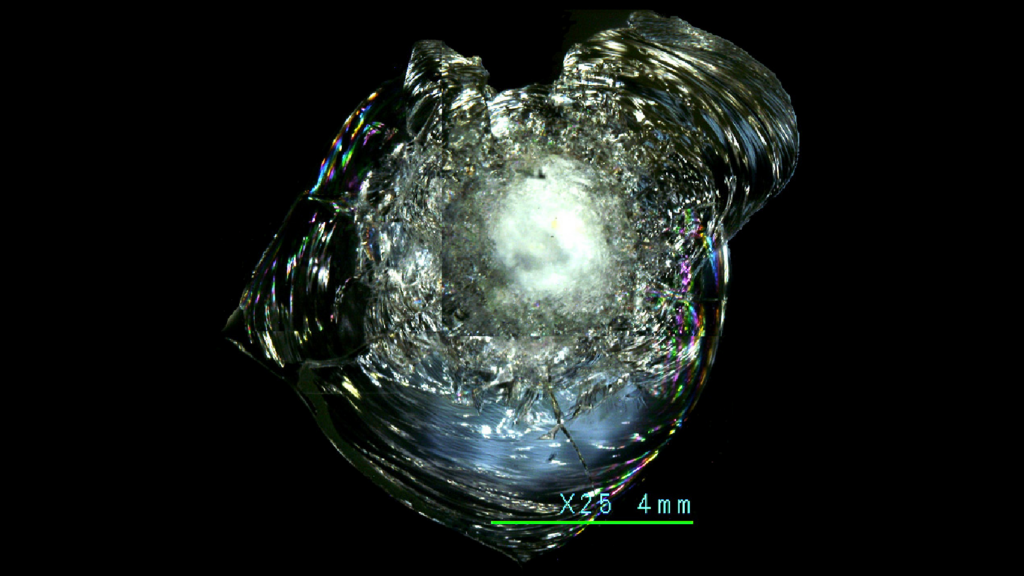
Picture of damage from the impact of a small piece of space debris discovered on STS-126 Window No. 6. (Credit: NASA)
WASHINGTON — The Intelligence Advanced Research Projects Activity’s (IARPA) new program to detect tiny, but potentially deadly, space junk will explore a wide range of cutting-edge technologies — from novel types of sensors exploiting plasma physics to specialized AI algorithms to trawl through currently available data from radar and telescopes, according to the program lead.
“We want to offer multiple potential solutions to the government,” Alexis Truitt, Space Debris Identification and Tracking (SINTRA) program manager at IARPA, told Breaking Defense.
SINTRA is targeted at what is often called “lethal but untrackable” space debris, pieces between 1 millimeter and 10 centimeters in diameter, that currently escape available sensor systems, including the Space Surveillance Network run by Space Command’s 18th Space Control Squadron. The program will be looking to find and keep tabs on such small debris from low Earth orbit (LEO) all the way up to the geosynchronous (GEO) belt, although Truitt notes that there is special interest in LEO’s bad neighborhood of around 800 kilometers.
“Currently, there are over 100 million objects greater than 1 mm orbiting the Earth, however, less than 1 percent of debris that can cause mission-ending damage are currently tracked,” IARPA’s website for the SINTRA project notes.
IARPA first signaled the debris-hunting program in a request for information last February, and announced on Aug. 2 that it had chosen four prime contractors, each leading a multi-faceted team of subcontractors: SRI International, an independent nonprofit research institute headquartered in Menlo Park, Calif.; Advanced Space, headquartered in Boulder, Colo.; BlueHalo, headquartered in Arlington, Va.; and West Virginia University Research Corporation, Morgantown, W. Va.
IARPA, like its sister military agency DARPA, doesn’t have an operational mission, but instead is charged with early research on complex technology challenges, with the goal of transitioning successful work to the Intelligence Community and other government agencies.
In the case of SINTRA, Truitt explained, potential transition partners include the Space Force, NASA and other Defense Department and IC agencies, including the National Reconnaissance Office that develops and operates the bulk of US spy satellites.
“We’re gonna bring them in for quarterly stakeholder meetings to let them know what the progress is for the four teams so they can track, and provide recommendations on what an end-solution looks like for them to actually use it operationally,” she said.
The SINTRA research program has two phases running across four years, Truitt said.
“The first stage is a two-year effort to establish a proof of concept to detect, track and characterize debris; if you’re using a new technique, to prove that it works,” she elaborated. “The second phase is enabling persistence, so developing an automated way to do that detection.”
The first milestone, at the nine-month mark, will involve a group of Federally Funded Research and Development Centers (FFRDCs) assessing each vendor’s concepts, Truitt said. The FFRDCs involved are: Massachusetts Institute of Technology’s Lincoln Laboratory, Naval Research Laboratory, Los Alamos National Laboratory, and Johns Hopkins University’s Applied Physics Laboratory.
SINTRA is casting a wide net over the types of sensor technologies and tracking methodologies that could be brought to bear. This includes finding debris based on its creation of solitons as it orbits — the subject of Truitt’s own plasma physics work — which are unique waves that can appear in any fluid, as well as the vacuum of space. But there are many other ways to track small debris, which often travels around the Earth in dense “clouds,” sort of like tiny versions of the the asteroid belt between Jupiter and Mars.
“The debris interacts with its surrounding environment, there could be a host of effects that could be created that we could detect from a variety of sensors. So, there could be some electrostatic discharge, there could be a plasma density, there could be some drag in the orbit as the as the debris orbits around the Earth, because of the low orbit, it could be dragged by the atmosphere of the Earth and, you know, maybe we can detect that drag better,” Truitt explained.
“Then there are a host of other new approaches beyond the plasma and the electrostatic and the electromagnetic signatures, that the team would like to explore as well. And across the board, we’re looking at ground and space based sensors, looking at existing data in a new way,” she added.
In particular, IARPA is interested in ways that artificial intelligence (AI) algorithms can be used to comb through existing sensor data from ground-based radar and telescopes to catch traces of small debris that up to now essentially has been left on the cutting room floor of current sensor networks.
“We have teams that are looking at this from advanced, artificial intelligence and machine learning perspective, looking at really low signal to noise signatures that are really hard to detect and track unless you understand the underlying physics,” Truitt said.
L3Harris selloffs hampered by low bids, CEO says
“To the extent we can get a good price for what we’ve identified as non-core [businesses], we’ll do it. But too many of the offers are coming in low and people think we’re desperate to sell, and I can assure you we’re not,” said L3Harris CEO Chris Kubasik.



























